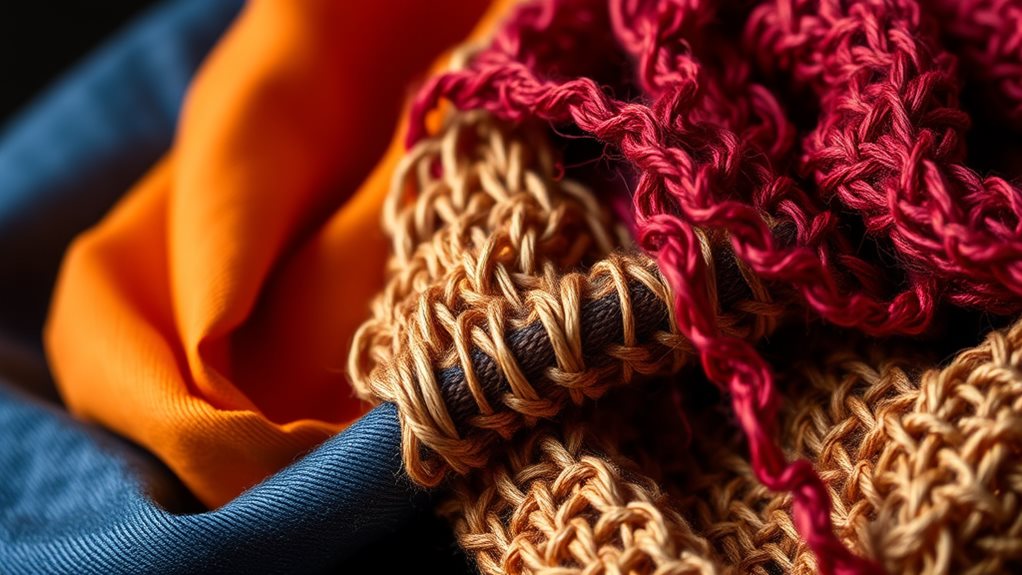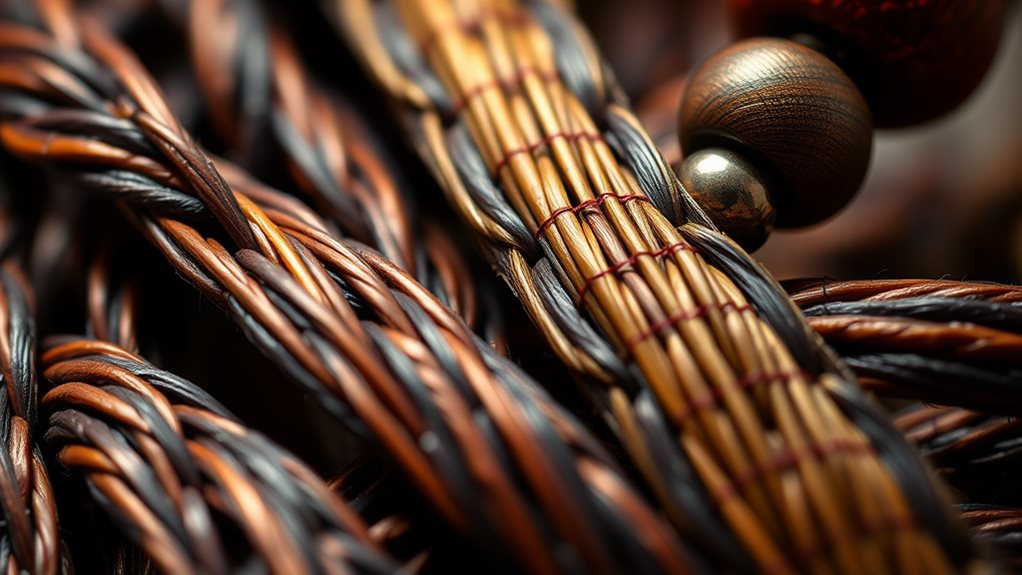The Philippines offers a wide variety of stunning woven gifts made from natural materials. Abaca and rattan are the primary materials used for these woven gifts, often crafted into intricately designed bags and baskets.
One of the unique features of these gifts is the incorporation of beautiful Capiz shell accents and home décor, which add an extra layer of cultural significance. Ancestral designs from various regions are often depicted in these pieces, reflecting the diverse styles and cultural stories of the Philippines.
These gifts are not only aesthetically pleasing but also ethically made, ensuring fair labor practices. The exceptional craftsmanship guarantees quality and durability, making each piece a testament to the artistry and attention to detail of the Filipino artisans.
Exquisite Philippine Textiles

The Philippines boasts a rich textile history, with intricate fabrics reflecting the country's cultural heritage.
Filipino textiles have a centuries-long history, showcasing the ingenuity of local artisans. Pre-colonial Filipinos used abaca, pineapple, and cotton to create practical textiles.
The Spanish colonial period introduced silk and satin, influencing local techniques and resulting in a unique fusion of indigenous and foreign styles.
Each region in the Philippines developed its own distinctive weaving style and patterns, reflecting diverse cultural influences.
These designs tell stories, expressing beliefs and traditions, and often signify social status, cultural affiliation, and spiritual significance. For example, ancestral motifs, animals, and plants are woven into fabrics to connect the present to the past.
Weaving is deeply rooted in spiritual practices, often serving as a bridge to spirits for protection and good health. Traditional tools like the backstrap loom, foot loom, and pedal loom are still used today.
The meticulous craftsmanship involved in creating these textiles reflects generations of expertise.
The use of natural materials and traditional dyeing techniques is essential to the textile-making process.
Vibrant colors achieved through these techniques add to the beauty and cultural significance of the fabrics. This blend of traditional artistry and modern interpretations guarantees a continued appreciation for this important part of Philippine heritage.
Woven Bags and Baskets
The Philippines has a rich tradition of woven bags and baskets crafted from natural materials like rattan, bamboo, abacá, and pandan leaves. These materials are chosen for their durability and versatility, with rattan being a primary material due to its strength and adaptability.
The craftsmanship of these bags and baskets involves diverse weaving techniques, including wicker, twine, and coiled weaves. These techniques are passed down through generations, reflecting the cultural significance of this traditional craft.
In the Philippines, woven bags and baskets hold crucial cultural importance as status symbols and vital tools for daily life. In the Cordillera region, different tribes boast unique designs, reflecting their cultural identities. For example, the Bontoc tribe uses the *koppit* bag to carry food, while the Ifugao tribe uses the *sangi* bag for clothing and personal items. The *takba* bag is used for general purposes by various tribes.
The production of these bags supports local communities, particularly women in rural areas. Brands like Uri and Narra Studio collaborate with these artisans, promoting sustainable practices and empowering communities.
This collaboration blends traditional techniques with modern appeal, creating functional and fashionable pieces. Each piece is intricately designed and tells a story, reflecting the cultural heritage of the Philippines.
Capiz Shell Wonders

Capiz Shell Origins and Uses
The capiz shell, derived from the *Placuna placenta* mollusk (also known as the "windowpane oyster"), is a translucent material that has been transforming homes and adorning cultural celebrations in the Philippines for centuries.
Its use in traditional Filipino architecture dates back centuries, where it served as a substitute for glass, allowing natural light in while maintaining privacy. Capiz shells have been used in crafting intricate lanterns, window panes, and decorative boxes.
Modern Applications and Decor
Today, capiz shells are incorporated into various modern applications, including home décor, fashion accessories, and jewelry.
Examples of modern uses include stunning chandeliers, lampshades, and wall panels. Artisans also create unique wall art, picture frames, and serving trays using capiz shells.
Harvesting and Processing
Capiz shells are carefully collected by fishermen. The shells are then cleaned, polished, and sometimes treated with bleach or dye.
Skilled artisans trim and layer the shells, often adding metal binding for strength. To guarantee the continued availability of capiz shells, responsible harvesting and processing practices are essential, ensuring the livelihoods of those who depend on it.
Cultural Significance and Sustainability
In the Philippines, capiz shells hold profound cultural significance, symbolizing prosperity and good luck.
They enrich festivities and traditions. Supporting capiz shell artisans contributes to fair trade and the preservation of this unique craft.
Intricate Wooden Crafts
The Philippines has four distinct styles of woodcarving, each reflecting unique cultural traditions and artistic approaches.
The Ifugao style from Northern Luzon is known for its spiritual carvings, often featuring bul-ul, granary deities paired with female idols to guarantee bountiful harvests. Ifugao carvers use available woods like ipil, acacia, and gutmu due to restrictions on hardwoods.
In contrast, the Tagbanua style from Palawan is characterized by sophisticated and highly stylized carvings, almost abstract in nature. These carvings feature the use of alimutyugani wood, blackened with soot and etched with white designs using a pisaw. Common designs include polka dots, v-marks, and triangles.
The Maranao style, influenced by their Muslim faith, avoids figural representations and focuses on intricate okkil designs inspired by flora, fauna, and local objects. These motifs can be found on musical instruments, kitchenware, and other items.
The Paete style from Laguna represents a refined art form, with the town's name meaning "chisel." While acacia remains a favorite wood, the logging ban has led many to use paper mache.
Paete craftsmen create detailed work on various home and kitchen items.
Philippine-Made Jewelry

Philippine-made jewelry is a vibrant reflection of the country's rich cultural heritage and artistry. This is evident in the diverse traditions of various indigenous groups, which are showcased through intricate designs and meticulous craftsmanship. For instance, the T'Boli tribe collaborates with brands like Nawa to create brass bangles that blend traditional techniques with modern aesthetics.
Some notable brands focus on specific aspects of Philippine culture. Angkan is known for its traditional *Agimat* necklaces, which hold cultural significance and are believed to possess magical powers. In contrast, Amami focuses on reviving endangered traditions by creating Ivatan silver and gold jewelry.
Many Philippine jewelry brands prioritize sustainable and ethical practices. They use recycled materials and ensure fair wages for artisans, supporting communities while providing beautiful, ethically-sourced jewelry. This commitment to sustainability is evident in the use of eco-friendly materials and the promotion of fair labor standards.
The impact of these brands extends beyond the artisans themselves. Many brands donate portions of their proceeds to support education and uplift communities, giving each purchase greater meaning. For example, some brands allocate funds to support local education initiatives, while others focus on promoting cultural heritage preservation.
Innovative and contemporary designs are also emerging in the Philippine jewelry scene. Designers blend traditional motifs with modern aesthetics, resulting in unique pieces like pearl jewelry, bakunawa-inspired cuffs, and laser-cut necklaces featuring Baybayin script. These designs reflect the creativity and innovation of established and emerging designers who push the boundaries of traditional jewelry-making techniques.
| Brand | Style | Focus |
|---|---|---|
| Angkan | *Agimat* necklaces | Traditional, cultural significance |
| Nawa | Brass jewelry | Collaboration with T'Boli tribes |
| Amami | Ivatan silver & gold | Reviving endangered traditions |
Home Decor and Accents
Philippine Home Decor Combines Traditional Craftsmanship with Modern Design****
Philippine home decor showcases the unique blend of traditional craftsmanship and modern design. This distinct style is achieved through the use of natural materials, such as Nito vines, which are sustainably harvested from the southern islands.
Nito vines are slender climbing ferns that are stored and prepared meticulously before being split into thin strips and expertly woven into functional and decorative items. These items include placemats, baskets, wine holders, and unique tissue box covers.
For example, the Cube Nito Tissue Box Cover takes two days to complete, demonstrating the dedication of the weavers. This meticulous craftsmanship is at the heart of sustainable home decor.
Sustainable Craftsmanship is Key to Philippine Home Accents
Sustainable craftsmanship is essential to Philippine home accents, which often feature Nito vines, Capiz seashells, and vibrant textiles from Thailand.
A Capiz Seashell chandelier can illuminate a space, while a set of Nito vine placemats adds natural elegance to a dining table. These items not only showcase beauty but also reflect a commitment to supporting local artisans and preserving traditional techniques.
Empowering Communities through Fair Wages and Heritage Preservation****
Businesses like Kouboo and Woven PH empower communities by ensuring fair wages and promoting the heritage of these crafts.
Each piece undergoes a thorough inspection, guaranteeing high quality and durability. From the careful weaving to the protective varnish, meticulous detail is evident in every item. This ensures that customers can find unique, customized options to perfectly complement their home's style.
Questions and Answers
Are These Products Ethically Sourced?
These products are made with ethical production methods. They work with local artisans, providing them with fair wages. This approach supports the artisans' communities and helps preserve their cultural heritage. By choosing these products, you are contributing to the artisans' sustainable livelihoods and the preservation of their cultural traditions.
What Are the Shipping Costs?
Shipping costs vary depending on several factors. Weight and destination are the primary factors that determine shipping costs.
International shipping rates and options differ significantly. For instance, shipping a 1-pound package from the US to Europe can range from $10 to $30, depending on the shipping carrier and speed of delivery. In contrast, local delivery is generally cheaper. For example, shipping the same 1-pound package within the US can cost between $5 to $15.
It's essential to note that shipping rates can also vary depending on the shipping carrier and the level of service chosen. Understanding these factors can help you make informed decisions when shipping packages.
Do You Offer Wholesale Prices?
We offer wholesale pricing for bulk orders. Our wholesale pricing tiers have minimum order requirements. To get specific pricing information, contact us with the details of your order. Competitive rates are available for large quantities.
Can I Customize a Design?
You can explore personalized options for customizing a design. Customization options are available for certain items and are dependent on the artisan. For example, some artisans may allow changes to colors or patterns, while others may have more restrictive options.
What Is Your Return Policy?
Our return policy depends on the seller. Each seller has their own exchange process and refund options. To learn more about a specific seller's return policy, contact them directly.